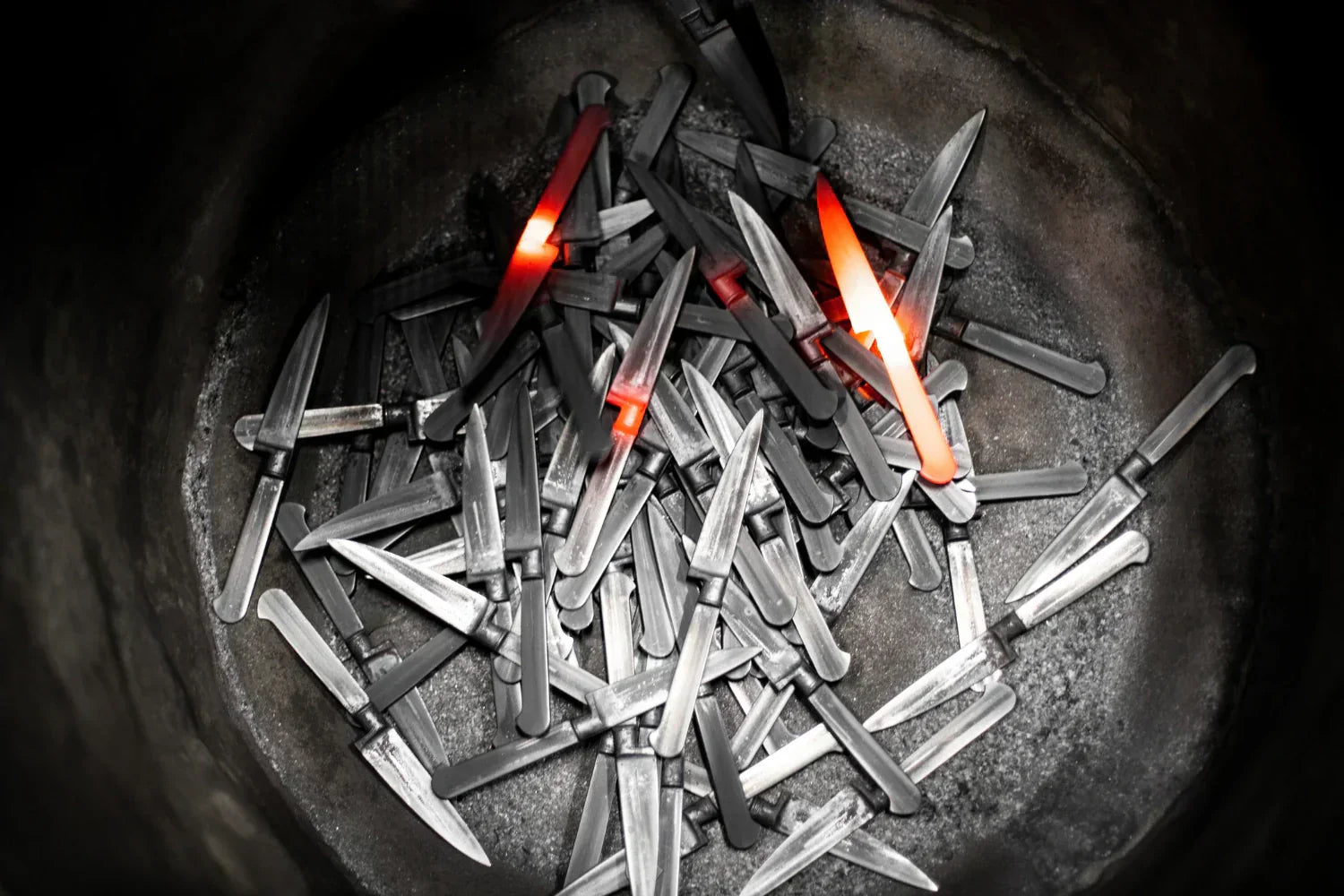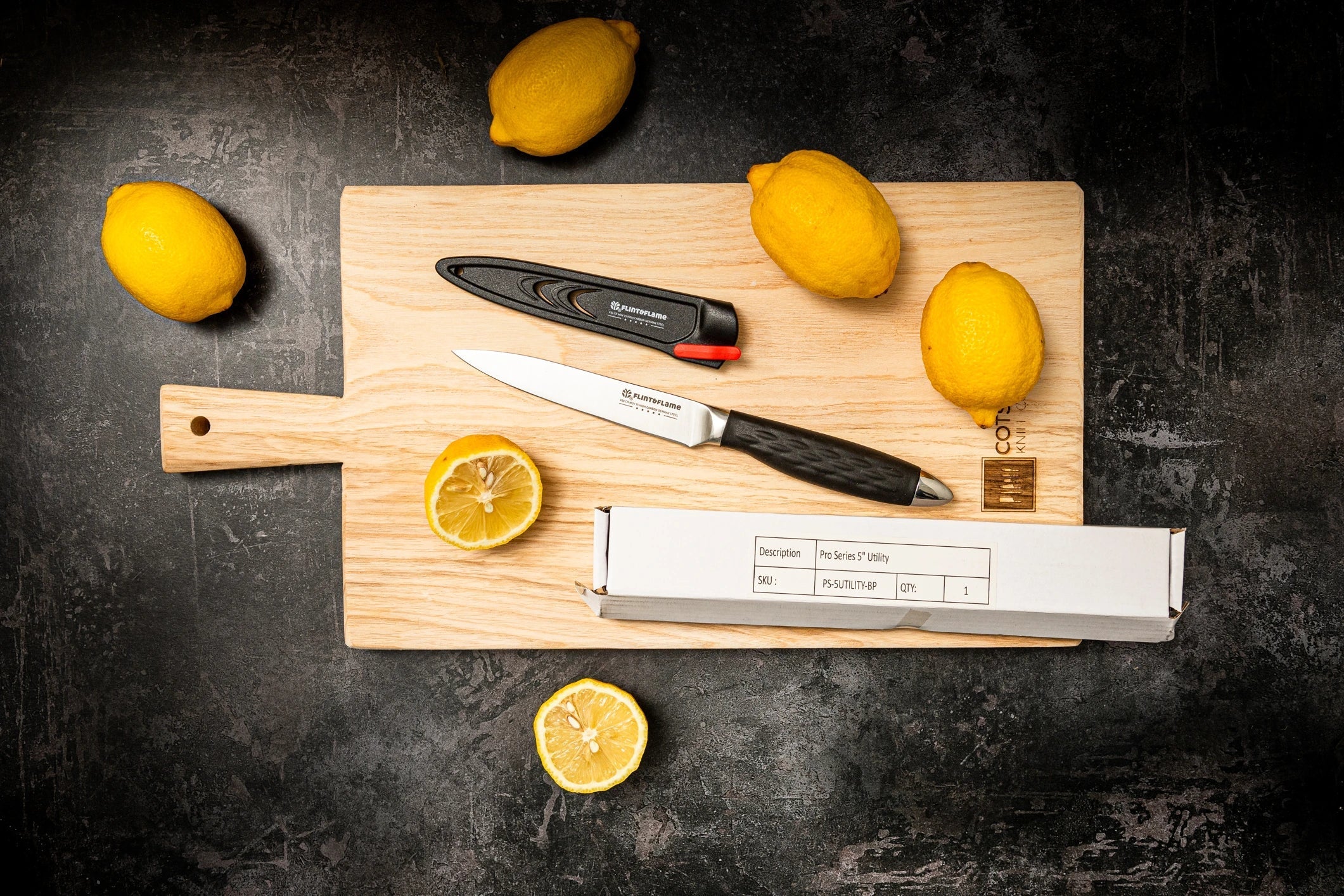The Full Guide to Carving Knives

A carving knife is a long, narrow kitchen knife designed specifically for slicing cooked meats with control and that extra precision you have been lacking. It typically features a blade between 20 and 30cm in length, allowing for smooth strokes that reduce tearing while also preserving the structure of the meat.
The blade is slim and pointed which will help you cut around bones and joints with great accuracy. This makes it ideal for carving roasts, poultry, hams, brisket, and other large cuts of meat.
Some home chefs also use carving knives to portion large fruits like melons or pineapples, where a longer blade is useful for clean, efficient slicing.
If presentation is important to you at the Sunday roast, Easter Lunch, or any other special occasion, the carving knife is the tool that makes every slice look deliberate, tidy, and professional.
Key Features & Characteristics
A carving knife is built for control and cutting-edge precision. Every detail in its design serves one purpose: clean, consistent slices with minimal effort.
Long, Narrow Blade
Pointed or Rounded Tip
The tip of a carving knife varies depending on preference:
- A pointed tip offers more control around bones and joints.
- A rounded tip provides a slightly safer, softer finish for clean slicing without piercing.
Both serve the same purpose - it comes down to comfort and style.

Granton Edge
Some carving knives include a Granton edge - a series of small dimples or scallops along the blade. These indentations create tiny air pockets that impressively prevent food from sticking to the knife, making each slice smoother and reducing drag.
A Granton-edged carving knife is especially useful when cutting meats with a softer interior or higher moisture content, like roast beef.
Blade Flexibility
Carving knives come in two main variants: stiff blades and slightly flexible blades. Each serves a specific purpose depending on how and what you carve.
Stiff Blades
A stiff blade gives you stability and control, which is ideal for carving uniform slices from large, boneless cuts like roast beef or pork loin. The rigidity ensures a straight, smooth cut every time, without deviation.
Slightly Flexible Blades
A blade with a touch of flexibility is better suited for navigating around bones or joints - such as when carving poultry or bone-in lamb. That bit of give allows the knife to follow the natural curves of the meat, helping you extract clean slices without hacking or tearing.
For precise carving (especially on presentation-worthy occasions) blade flexibility offers control, reduces waste, and helps you serve meat that’s both beautiful and well- proportioned.
Edge Retention & Sharpness
A carving knife is only as good as its edge. Whether you’re slicing roast beef or a leg of lamb, a dull blade will tear and shred instead of gliding cleanly — ruining both presentation and texture.
That’s why edge retention is crucial. High-quality carving knives are made from hardened stainless or high-carbon steel, materials known for holding a razor-sharp edge over time.
A sharp carving knife gives you:
- Clean, uniform slices without pressure or sawing
- Preserved juices and structure in meats (no tearing)
- Greater control, especially when working close to bones or joints
In short, when your carving knife holds its edge, you get consistent results every time - with less effort + maximum precision.

Proper Technique & Safety Tips
Mastering a carving knife isn’t just about the blade… it’s also about how you use it. Great technique ensures cleaner slices, greater control, and less mess at the table. Here are 4 great tips:
1. Use Long, Steady Strokes
Avoid forcing the blade. A good carving knife should do the work for you. Use long, smooth motions, starting at the heel of the blade and drawing through to the tip. This reduces tearing and preserves the structure of meats like roast beef, lamb leg, or whole chicken.
2. Stabilise with a Carving Fork
A carving fork isn’t just for show. It’s essential for stability. Holding the meat firmly with a two-pronged fork keeps your fingers safely out of the way and ensures the roast stays steady while slicing.
3. Slice Against the Grain
For tender results, always cut against the grain of the meat. This shortens the muscle fibres and enhances texture.
4. Safety First
Make sure your carving surface is secure and non-slip. Avoid glass or overly smooth boards, and always keep your non-dominant hand clear of the blade’s path.

Maintenance & Care
A carving knife is an investment. And like any high-quality tool, it deserves proper upkeep to stay at peak performance.
Hand Wash Only
Never put your carving knife in the dishwasher. The harsh heat, moisture, and detergents can dull the edge and damage the handle. Instead, rinse with warm water and mild soap, then dry immediately with a soft cloth.
Hone Regularly
Keep your edge aligned with a honing rod. A quick hone before each use helps maintain sharpness and ensures clean, consistent cuts.
Sharpen Occasionally
Even the best blades need a proper sharpening from time to time. Depending on frequency of use, sharpen every few months using a whetstone or have it professionally serviced.
Store Safely
Avoid tossing your knife in a drawer. Use a magnetic strip, a knife block, or a protective blade guard to keep it safe and protect the edge from damage.
Avoid Hard Surfaces
Using your carving knife on glass, marble, or ceramic boards will dull your serration fast. Stick with wood or high-quality plastic boards that are gentle on the edge.
A well-maintained carving knife will serve you for years - with every Sunday roast and Christmas dinner made smoother and more satisfying.
Choosing the Right Carving Knife
Not all carving knives are made equal. Finding the right one depends on your needs, preferences, and the type of meat you carve most often.
Length Preferences
Most carving knives range from 20cm to 30cm
- Longer blades allow you to make cleaner, uninterrupted slices through larger joints like beef sirloin or lamb leg.
- Shorter blades offer better control for poultry or smaller cuts.
Handle Comfort and Grip
The handle should feel like a natural extension of your hand.
Look for ergonomic designs with a smooth but secure grip. A good handle gives you control - a great one gives you confidence when in the kitchen.
Balance and Weight Considerations
A well-balanced carving knife reduces fatigue while promoting precision. The weight should feel evenly distributed between the blade and handle - not tip-heavy or awkward. You want a knife that moves with intention, not effort.
Match the Knife to the Task
- For boneless roasts or brisket, choose a longer, narrow blade for smooth, consistent slices.
- For poultry or bone-in joints, a slightly shorter knife with subtle flexibility can help you carve cleanly around joints.
Handle Material
Wood, composite, or stainless steel handles are all viable - it comes down to feel and aesthetic. Just ensure it offers durability and a good grip.
Blade Material & Sharpness
Opt in for high-carbon stainless steel for excellent edge retention, corrosion resistance, and sharpness. A razor-sharp edge is essential - especially if you want to glide through meat without tearing.

FAQs
Is a carving fork necessary?
While not essential, a carving fork is highly recommended. It helps stabilise the meat, keeps your fingers safely away from the blade, and allows for more consistent slices. Especially when carving large joints or roasts, it makes the process cleaner and more precise.
Should a carving knife be sharp?
Absolutely. A carving knife should be razor sharp. A dull blade will tear the meat, ruin presentation, and require unnecessary pressure - increasing the risk of slipping or injury. A sharp carving knife glides through joints effortlessly, delivering clean, even slices with minimal effort.
Why Invest in a Carving Knife?
A carving knife isn’t just for special occasions… it’s a staple for anyone who takes pride in how their food is served.
Whether it’s a Sunday roast or simply slicing cold cuts, the right carving knife transforms the experience
- Cleaner slices
- Better presentation
- Less effort
Investing in a premium carving knife means longer-lasting sharpness, smoother control, and a blade that performs beautifully for years - not just months. If you’ve ever hacked through a roast with a blunt or bulky knife, you’ll know the difference.
Invest once… And enjoy the results every time you carve.




